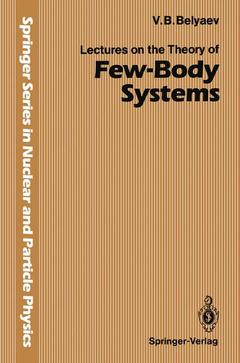Lectures on the Theory of Few-Body Systems, Softcover reprint of the original 1st ed. 1990 Springer Series in Nuclear and Particle Physics Series
Langue : Anglais
Auteur : Belyaev Vladimir B.

Nuclear physics is undoubtedly a many-body problem. A nice introduction into the present status of this subject may be found in the comprehensive mono graph by P. Ring and P. Schuck "The Nuclear Many-Body Problem" (Springer, Berlin, Heidelberg, New York 1980). However, in view of the many challenging problems that remain to be tackled, it is sensible to consider systems with few particles as model cases. These provide the basis for solving the sophisticated many-body problem posed by intermediate and heavy nuclei. Out of the large number of existing nuclear systems, few-particle, that is few-nucleon, systems can be singled out to form a special group. This is possi ble because a comparatively small number of degrees of freedom (or dynamic variables) is required for a complete description of such systems. In these Lectures we utilize this to study few-body systems in great detail, in particular three-and four-body systems. In contrast to published monographs on the subject, we deal not just with nucleonic degrees of freedom but consider also non-nucleonic degrees of freedom. The range of approaches and methods examined exceeds the scope of other textbooks. The Lectures are organized in such a way as to guide the uninitiated reader through the essentials of solving the dynamical equations of few-body systems directly towards practical applications. Formally oriented readers might like to supplement their reading with texts such as "The Quantum Mechanical Few Body Problem" by W. GlOckle (Springer, Berlin, Heidelberg, New York 1983).
1. The Two-Body Problem.- 1.1 Properties of the Two-Particle t-Matrix.- 1.2 Phase-Equivalent Potentials.- 1.3 Separable Expansions of the t-Matrix.- 2. The Fadeev-Equations in the Three-Body Problem. Pion-Nucleus Scattering.- 2.1 General Remarks.- 2.2 Formal Derivations for Transition Amplitudes and Wave Functions.- 2.3 Scattering of a Particle on a Bound Pair.- 2.4 Interpolation Method in the Solution of the Faddeev Equations.- 2.5 The Alt-Grassberger-Sandhas Form of the Faddeev Equations.- 2.6 The Karlsson and Zeiger Form of the Faddeev Equations.- 2.7 Solution by Means of the Method of Moments and Spline Functions.- 2.8 Unitarization of Approximate Solutions.- 2.9 Dispersion Methods in the Three-Body Problem.- 2.10 Unitarization Based on the Evolutionary Coupling Constant (ECC) Method.- 2.11 Splitting of the Three-Particle Wave Function into “Internal” and “External” Parts.- 3. The Four-Body Problem.- 3.1 The Integral and Differential Yakubovsky Equation.- 3.2 Four-Particle AGS Equations.- 3.3 Approximate Four-Particle Equations for the ? (3N) System.- 3.4 Scattering of n(p) by Nuclei Consisting of Three Nucleons at Low Energies.- 3.5 NN-Scattering in the Nonrelativistic Quark Model (The Six-Body Problem).- 4. Related Problems.- 4.1 The Faddeev Equations and the Heisenberg Ferromagnetic.- 4.2 Sum Rules andvirial Coefficients.- 4.3 Systems Involving Variable Numbers of Particles.- 5. Outlook.- General Reading.- References.
Date de parution : 05-2012
Ouvrage de 134 p.
15.5x23.5 cm
Thème de Lectures on the Theory of Few-Body Systems :
© 2024 LAVOISIER S.A.S.



